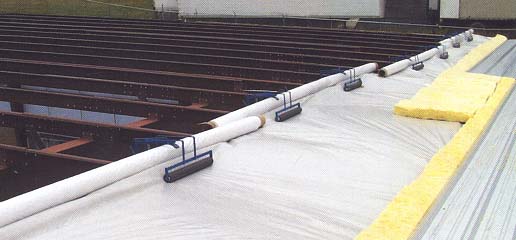- Standard Number:
OSHA requirements are set by statute, standards and regulations. Our interpretation letters explain these requirements and how they apply to particular circumstances, but they cannot create additional employer obligations. This letter constitutes OSHA's interpretation of the requirements discussed. Note that our enforcement guidance may be affected by changes to OSHA rules. Also, from time to time we update our guidance in response to new information. To keep apprised of such developments, you can consult OSHA's website at https://www.osha.gov.
January 15, 2003
Gary Romes, Vice President
Guardian Fiberglass
1000 East North Street
Albion, Michigan 49224
Dear Mr. Romes:
This is in response to your letter of October 9, 2002, regarding your Guardian Fiberglass Purlin Glide FP Insulation System ("Purlin Glide"). You had previously written to us about the Purlin Glide in an August 22, 2001, letter, to which we responded on June 24, 2002. The question you asked was whether the Purlin Glide met OSHA requirements.
June 24, 2002 OSHA Letter
In our previous letter, we stated:
The system is typically used during the installation of metal roofing systems on steel structures. The requirements for fall protection during the installation of such metal roofing are covered by the steel erection standard, 29 CFR 1926.750-1926.761. Your product is designed to serve as a cover to prevent falls through openings. Under §1926.754(e)(3)(i), covers for roof openings must "be capable of supporting, without failure, twice the weight of the employees, equipment and materials that may be imposed on the cover at any one time." Assuming the validity of the test data,1 the system typically would meet this requirement (when used in accordance with the manufacturer's instructions) for preventing an employee from going through an opening.
Current Question: You indicate that some parts of the system have been redesigned and have subsequently conducted additional testing on the system. In this round of testing, you conducted static tests using 1,022 pounds to simulate the load of twice the weight of two workers with their equipment. You have asked us to review the materials in light of the applicable OSHA requirements.
Response: OSHA is generally precluded from approving or endorsing specific products. The variable working conditions at job sites and possible alteration or misapplication of an otherwise safe piece of equipment could easily create a hazardous condition beyond the control of the equipment manufacturer. However, where appropriate, we try to give some guidance to help employers assess whether products are appropriate to use in light of OSHA requirements.
Submitted Information: Based on the information you have supplied, we understand the Purlin Glide to be a system used as part of the installation of metal roofing. In this system, an assembly of rolls of "vapor retarder facing," which is a synthetic sheet material, is pushed out (with long poles) ahead of the area about to be decked. As it is pushed out, the sheet material deploys from the rolls, covering the steel purlins. A row of insulation and metal roofing is then installed over the sheet material. The Purlin Glide system is then advanced again, and the next row of insulation and roof decking is installed, etc. When used according to the manufacturer's instructions, there is always at least 6 feet of sheeting covering the purlins ahead of the row in which the insulation and decking is being installed (between the sheeting rolls and the leading edge of the metal decking). The system advances parallel to the direction of the purlins.
One of the designed purposes of the sheeting material is to prevent workers installing the roofing system from falling in the area below and in front of the leading edge of the roof panels that are being installed. The system is not designed to address fall hazards to the perimeters of the structure, during the set-up and removal of the apparatus, or during the process of replacing a spent roll of vapor barrier.

The manufacturer's instructions include a restriction against using the system where the purlins are more than a specified distance apart and a requirement that the decking be completely attached before advancing the system.
You submitted testing results, signed by a registered professional engineer, showing that the sheeting material will withstand a static test using a two sand bags with a total combined weight of 1,022 pounds.
Applicable Standards
The system is typically used during the installation of metal roofing systems on steel structures. The requirements for fall protection during the installation of such metal roofing are covered by the steel erection standard, 29 CFR 1926.750-1926.761. Your product is designed to serve as a cover to prevent falls through openings.
Under §1926.754(e)(3)(i), covers for roof openings must "be capable of supporting, without failure, twice the weight of the employees, equipment, and materials that may be imposed on the cover at any one time." Based on the submitted information (supporting both your August 22, 2001, letter and your October 9, 2002, letter),2 the system typically would meet the applicable OSHA requirements, which in this case are the floor cover requirements for roof openings in §1926.754(e)(3)(i), for preventing falls at the leading edge during the metal decking installation process, when the Purlin Glide is used in accordance with the manufacturer's instructions.
If you need additional information, please do not hesitate to contact us by fax at: U.S. Department of Labor, OSHA, Directorate of Construction, Office of Construction Standards and Guidance, fax # 202-693-1689. You can also contact us by mail at the above office, Room N3468, 200 Constitution Avenue, N.W., Washington, D.C. 20210, although there will be a delay in our receiving correspondence by mail.
Sincerely,
Russell B. Swanson, Director
Directorate of Construction
1 This office does not independently test products or validate submitted test data. [ back to text ]
2 This assumes the validity of test data; this office does not independently test products or validate submitted test data. [ back to text ]

